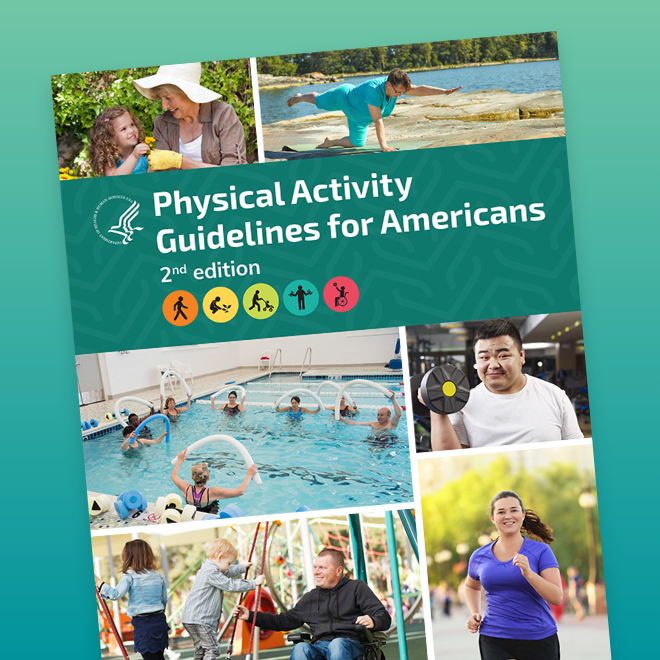The Physical Activity Guidelines for Americans report provides evidence-based recommendations for adults and youth ages 3 through 17 to safely get the physical activity they need to stay healthy.
The second edition, updated in 2018, offers new key guidelines for children ages 3 to 5 and new evidence that further demonstrates the health benefits of physical activity for individuals of all ages.
Guidelines for youth (3-5)
Preschool-aged children should be active throughout the day to enhance growth and development. Adults caring for children this age should encourage active play (light, moderate, or vigorous intensity) and aim for at least 3 hours per day.
Guidelines for Children and Adolescents
Children and adolescents ages 6 through 17 years should do 60 minutes (1 hour) or more of moderate-to-vigorous physical activity daily:
- Aerobic: Most of the 60 minutes or more per day should be either moderate- or vigorous-intensity and should include vigorous-intensity physical activity on at least 3 days a week.
- Muscle-strengthening: As part of their 60 minutes or more of daily physical activity, muscle-strengthening should be included at least 3 days a week.
- Bone-strengthening: As part of their 60 minutes or more of daily physical activity, bone-strengthening physical activity should be included at least 3 days a week.
Guidelines for Adults
Adults should do at least 150 minutes (2 hours and 30 minutes) to 300 minutes (5 hours) a week of moderate-intensity, or 75 minutes (1 hour and 15 minutes) to 150 minutes (2 hours and 30 minutes) a week of vigorous-intensity aerobic physical activity, or an equivalent combination of moderate- and vigorous-intensity aerobic activity. Preferably, aerobic activity should be spread throughout the week.
Move more, sit less
New evidence shows a strong relationship between increased sedentary behavior and increased risk of heart disease, high blood pressure, and all-cause mortality. All physical activity, especially moderate-to-vigorous activity, can help offset these risks.
Any physical activity counts
Americans can benefit from small amounts of moderate-to-vigorous physical activity throughout the day. The first edition of the Physical Activity Guidelines for Americans stated that only 10-minute bouts of physical activity counted toward meeting the guidelines. The second edition removes this requirement to encourage Americans to move more frequently throughout the day as they work toward meeting the guidelines.
Immediate health benefits
For example, physical activity can reduce anxiety and blood pressure and improve quality of sleep and insulin sensitivity.
Long-term health benefits
- For youth, physical activity can help improve cognition, bone health, fitness, and heart health. It can also reduce the risk of depression.
- For adults, physical activity helps prevent 8 types of cancer (bladder, breast, colon, endometrium, esophagus, kidney, stomach, and lung); reduces the risk of dementia (including Alzheimer’s disease), all-cause mortality, heart disease, stroke, high blood pressure, type 2 diabetes, and depression; and improves bone health, physical function, and quality of life.
- For older adults, physical activity also lowers the risk of falls and injuries from falls.
- For pregnant women, physical activity reduces the risk of postpartum depression.
- For all groups, physical activity reduces the risk of excessive weight gain and helps people maintain a healthy weight.
Managing chronic health conditions
For example, physical activity can decrease pain for those with osteoarthritis, reduce disease progression for hypertension and type 2 diabetes, reduce symptoms of anxiety and depression, and improve cognition for those with dementia, multiple sclerosis, ADHD, and Parkinson’s disease.
Explore the Second Edition of the Physical Activity Guidelines for Americans.
Find more physical activity resources specifically for:
- Older adults
- Pregnant women & new moms
- People with disabilities
- People with health conditions

